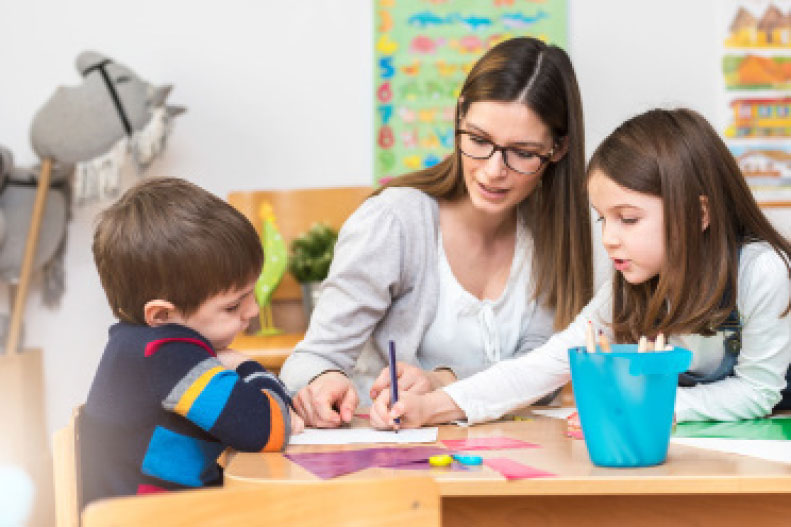A number of principles can inform the following approaches to teaching young learners.
Build teaching around activities and physical movement.
Link language learning to physical activities by having children use and hear English for making things, drawing pictures, completing puzzles, labelling pictures, matching words and pictures, playing games, acting out movements in response to instructions, and other activities that involve hands, eyes, and ears. Teachers often make use of TPR activities (activities based on linking language with actions, drawing on the method known as total physical response). Many listening activities for young children use this principle, such as activities in which children listen and respond to commands (e.g. ‘sit down’, ‘turn around’, ‘touch your nose’), listen and choose a picture, listen and draw a picture or listen and number a sequence of actions in a picture. Similarly, speaking activities with young learners may involve the use of songs, dialogues, chants, and fixed expressions that students can practice in different situations.
Build lessons around linked activities.
Since young learners have limited attention spans, it is important to include several short activities in a lesson and to move quickly from one activity to another. Activities of five to ten minutes in length are most successful. A balance between the following kinds of activities is often useful:
Quiet / noisy activities.
- Different skills: listening, talking, reading/writing.
- Individual work/pair work/group work / whole-class activities.
- Teacher–pupil /pupil–pupil activities
Build lessons around tasks.
A task is a meaning-focused activity that requires learners to draw on and use their existing linguistic resources to complete a task, such as drawing a picture from oral instructions, or working in pairs or groups, and sequencing a series of pictures to complete a story. The key features of classroom tasks for young language learners are: - They have coherence and unity for learners (from topic, activity and/or outcome).
- They have meaning and purpose for learners.
- They have clear language-learning goals.
- They involve the learner actively.
Provide scaffolding.
Scaffolding refers to how a child learns through collaboration with a more knowledgeable partner (a parent, a classmate, or a teacher). When children work collaboratively on tasks (such as sequencing pictures in a story, completing a puzzle, or completing an information-gap task), more proficient learners can often provide the scaffolding less proficient learners need.Involve students in creating resources that support their learning.
Learners can draw pictures of the characters they hear in a story or create puppets to help retell a story. They can colour pictures of items and characters from stories. They can find pictures in magazines, related to a theme or topic in a lesson, and bring them to class.Build lessons around themes.
Lessons can be built around topics or themes, such as animals, friends, food, or family, for very young learners; and for older learners, themes can be drawn from subjects in their other classes and the community, such as transport, country life, travel, and famous people. Theme-based lessons provide continuity across activities and enable English learning to be connected to the children’s lives.Choose content children are familiar with.
Teaching can also be built around familiar content from the children’s culture, such as stories and events (e.g., national holidays or cultural practices). Since the learners will be familiar with talking about these topics in their native language, it will be easier for them to connect with how they can talk about them in English.Use activities that involve collaboration.
Children enjoy socializing with other children, and activities that work best with young learners are those in which children are working with others in pairs or groups, rather than remaining in their seats, and listening to the teacher. Activities that involve collaboration require careful preparation to ensure that children have the words and expressions they need in order to carry out an activity.Create a supportive learning community in the classroom.
A class of young learners needs to become a community of learners – that is, a group of learners with shared goals, needs, and concerns. Thinking of a class as a community means seeing it as a place where each child in the class cooperates and collaborates to achieve the class’s common goals. This leads to more productive learning. Children who interact and collaborate with other learners develop a more positive attitude towards learning and a greater sense of self-confidence than those in other learning arrangements.Use enjoyable activities that children can accomplish without frustration.
Young learners enjoy taking part in activities that they can successfully achieve, but which also offer some kind of challenge. Activities of this kind depend on the teacher providing language input and modelling for young language learners, where the teacher and the materials are the primary sources of language.Provide rich language support.
Since the learners will have little knowledge of English to call upon, they need careful language support for learning activities. Success will depend on the teacher providing language models, demonstrating the way the activities can be carried out in English, and providing the language support an activity depends upon.Give clear goals and feedback.
Children like to be successful at things they do in class. In order to achieve this, it is important to set clear goals for children and to let them know when they have been successful, or if not, why not. Praise for success is very important for young learners, for example, by using stars, stickers, points, or smiley faces.Use English for classroom management.
Use English for instructions, for routines such as forming groups, for introducing activities, for giving feedback, and for other teaching processes.
Use the mother tongue when needed.
While the goal of teaching young learners is to use as much English in class as possible, when teaching homogeneous classes, it is quite appropriate to use the mother tongue when necessary to explain the meaning of words and expressions and to help explain activities. Occasional use of the mother tongue provides a comfort zone for young learners, though the teacher and students should not become over-dependent on it.
Bring speakers of English to class.
Where possible, it is useful to invite speakers of English to class to meet the learners. These could be children from an international school or older children who are now quite advanced in English. They can ask and answer simple questions, take part in a role-play, and do other activities that will interest and motivate the learners.
Source: https://www.professorjackrichards.com/



